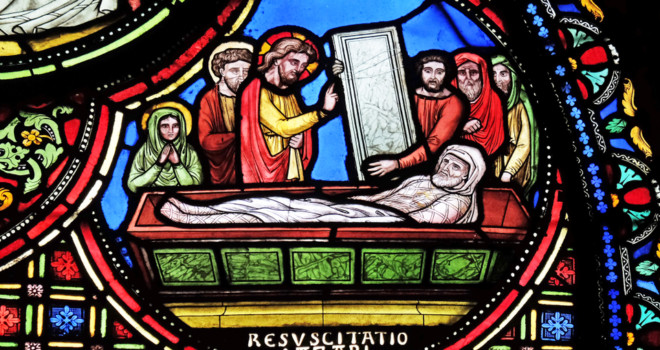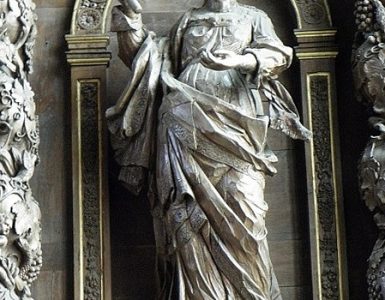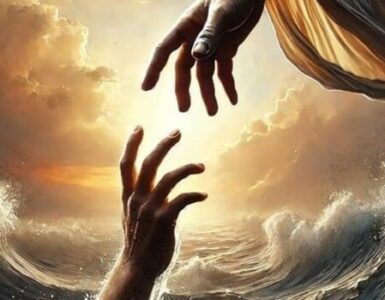Jesus nears Jerusalem. He is already at Bethany, a village at the foot of the Mount of Olives. His death nears, and what he does to prepare us for it is miraculous: He raises Lazarus from the dead.
Jesus was going up to Jerusalem to die, and it would seem that death’s empire was stronger than ever once he had fallen under its power. But he works the great miracle of the raising of Lazarus to show us that he is death’s master.
All of the terror of death is here before us. Lazarus is dead, enshrouded, entombed, and already decaying and putrid. They fear to move the stone covering his tomb lest they infect the place and loose its unbearable stench. Here is a horrid spectacle: Jesus shudders to see the tomb, and he weeps. In the death of his friend Lazarus he deplores the punishment shared by all men. He looks upon human nature as created for immortality, but condemned to death by sin. He is the friend of all mankind, and he comes to restore us. He commences by shedding a tear for our disaster and shuddering at the sight of the punishment that he himself will soon face for us. To him, what seems so awful about death is chiefly that it is caused by sin.
It is sin, rather than death, that moves him to shudder, to be troubled in spirit, and to weep. He is all the more greatly moved as he draws near the tomb. This frightful cavern where the dead man has been laid: what can be done? “Could not he who opened the eyes of the blind man have kept this man from dying?” (John 11:37). They did not ask whether he could raise him because they could not imagine it to be possible. They thought that all Jesus could offer in the presence of this evil were his tears and sorrow. Here is all mankind in death: nothing is to be done except to lament its fate. No other resource is at hand. So does the story begin. The opening scene is one of desolation.
Yet the second is all consolation, for we see the power and victory of Jesus over death.
Jesus says, “This illness is not unto death; it is for the glory of God” (John 11:4). Yet Lazarus did in fact die; what the Savior meant is that death would here be vanquished and the Son of God glorified in the victory. He continued: “Lazarus has fallen asleep, but I go to awaken him out of sleep” (John 11:11), calling his death a falling asleep and showing that it is as easy for him to raise the dead as to awaken a sleeper.
As he approaches, he is progressively revealed to be the victor over death. “If you had been here,” Martha says, “my brother would not have died. And even now I know that whatever you ask from God, God will give you” (John 11:21-22). You are all-powerful, not only to prevent death, but also to wrest its prey from its grasp. “Your brother will rise again.” “I know that he will,” says Martha, “on the last day” (cf. John 11:23-24). She does not doubt that Jesus can resurrect him before then, but she does not think herself worthy of that grace.

This article is from a meditation in Meditations for Lent.
Let us savor the words of Jesus to Martha, after which death has no sting: “I am the resurrection and the life; he who believes in me, though he die, yet shall he live, and whoever lives and believes in me shall never die” (John 11:25-26). He will never die. Death for him will be only a journey. He will not remain there, and he will arrive at a condition in which he will never die.
Martha’s faith is great. In her spirit she sees the general resurrection and confesses Jesus Christ as the One who, being in Heaven and in the Father’s bosom, is come into the world. Jesus, Son of the living God, lives with the same life as his Father. “As the Father has life in himself,” he says, “so he has granted the Son also to have life in himself ” (John 5:26). It is with good reason, then, that he tells us that he is “the resurrection and the life” and “as the Father raises the dead and gives them life, so also the Son gives life to whom he will” (John 5:21). He is a source of life; he is the same life as the Father. Life came to us when he became man. “We proclaim to you,” says St. John, “the eternal life which was with the Father and was made manifest to us” (1 John 1:2).
“Father, I know that thou hearest me always” (John 11:42, Douay-Rheims). Thus are we delivered, for such an intercessor speaks on our behalf. “Lazarus, come out.” The prophets had raised several men from the dead, but none of them had treated death in such an imperious manner. It was, as the Savior said, the hour “when the dead will hear the voice of the Son of God, and those who hear will live” (John 5:25). What is done now for Lazarus alone, one day will be done for all men.
It is important that we meditate upon these words and deeds so that we may be strengthened against the fear of death, which is so extreme in us that it is capable of making men lose their minds. We must arm ourselves against this fear, chiefly by meditating upon the promises of the Gospel and attaching ourselves with a living faith to the truth that Jesus has vanquished death. He did so in the case of a young girl still in her bed, a widow’s son being carried on a bier, and in the person of Lazarus. These three to whom he restored life remained mortal.
What was left for him to do was to vanquish mortality itself. It was in his own person that he would win so perfect a victory. After he had been put to death, he rose, never to die again, and without having first seen corruption, as the psalmist sings: “Thou wilt not let thy holy one see corruption” (Ps. 15:10, Douay-Rheims [RSV = Ps. 16:10]). What was done in the head will be accomplished in the members. Immortality has been assured to us by Jesus Christ.
✠
This article is from today’s meditation in Bishop Bossuet’s Meditations for Lent. It is available as an ebook or leatherette from Sophia Institute Press.












